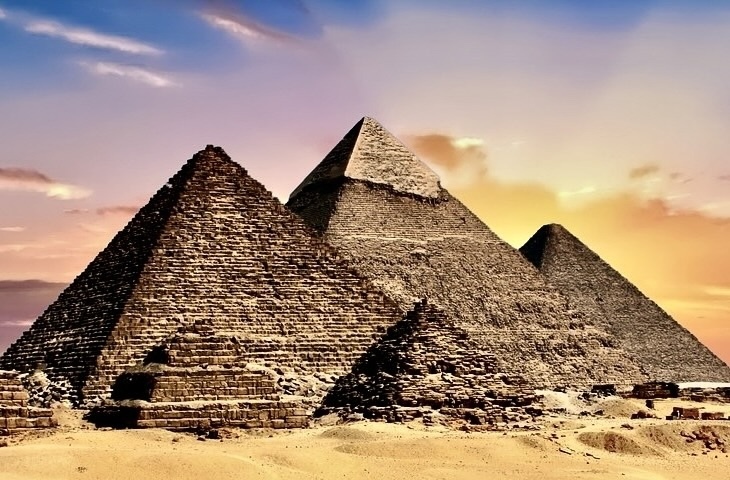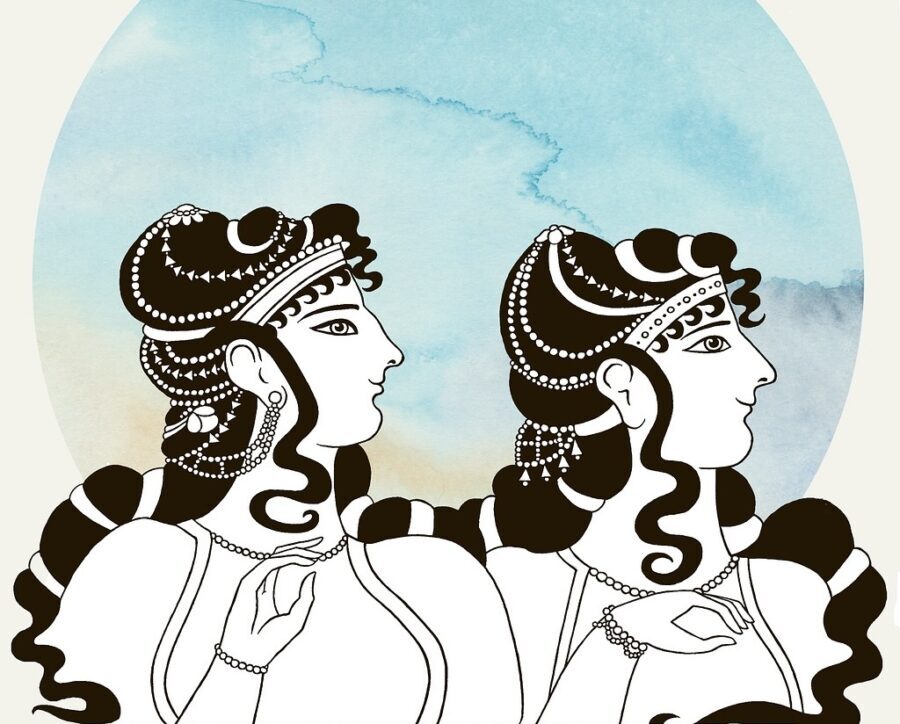By Eric Vasallo
Thebes – 1323 BCE
A caravan of high priests, members of the royal court and Grand Vizier Ay, the future ruler of Egypt, roll out the mummified boy king in his glinting gold sarcophagus and all his personal belongings. They ritually walk out in procession from King Tutankhamun’s mortuary temple. The wails of perfumed Egyptian women and temple singers echo against the tall, multi-colored columns of his temple.
Winding towards the Valley of the Kings, a stream of fiery torches pierces the night underneath the protective left eye of Horus (moon). The smell of Frankincense, Myrrh and Kyphi are carried by the wind. Ay leads the group, reverently depositing the boy king and all his goods, assuring his rebirth into the afterlife, sealing the tomb forever.
Valley of the Kings – 1319 BCE*
Two separate bands of tomb robbers enter the Antechamber Annex of the King’s tomb twice, rifling through his jewel caskets full of fine linens, clothing, and jewels. They searched for precious metals, easily re-commodified. A knotted scarf of fine linen containing a handful of solid gold rings (see below, right) belonging to the king were tossed into one of the boxes of the Antechamber.
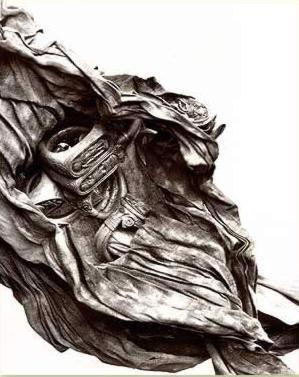
Another bundle containing the King’s linen loincloths was found dropped on the floor near the entryway, along with the diaphanous alabaster wishing cup carved in the form of lotuses — revealing that at least one group of robbers may have been caught in the act or overtaken while rushing out of the tomb.
Priests later restore a cursory order to the burial goods rifled through by the bands of looters. They quickly reseal the tomb entrance using fill that included broken pieces of grave goods left behind by the robbers. The seal is stamped with a necropolis seal made of clay, bearing the likeness of Anubis above nine bound captives on their knees. (Left: Griffith Institute – Harry Burton photograph – University of Oxford)
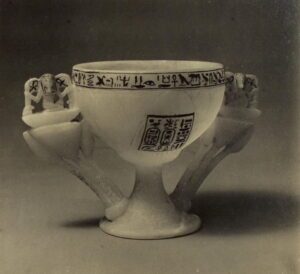
Valley of the Kings – November 4th 1922 CE – An Egyptian boy places a tray of water for the workers onto the sand and notices the ground was uneven. He brushes some sand aside and notices what appeared to be a cut stone step. The crew alerts Carter and he rushes to the dig site to examine. Carter and his team quickly uncover a complete stairway leading downwards to a wall where he finds a royal seal indicating a royal tomb.
Valley of the Kings – November 26th 1922 CE – With Lord Carnarvon standing anxiously beside, Howard Carter opens a small hole in the plastered wall made of fill. A rush of air, sealed within for thousands of years, escapes. A whiff of coconut oil and perfume tickles their senses. The candle Carter held in his hand flickers. He inserts the candle through the opening to peer inside.
He gasps.
He felt breathless at the sight of a room packed full of exquisitely crafted, royal and religious objects inside.
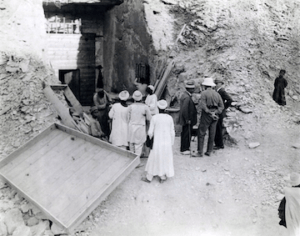
during his initial visit to the tomb, 1922 (National Portrait Gallery, London;
photo: Keystone Press Agency Ltd.)
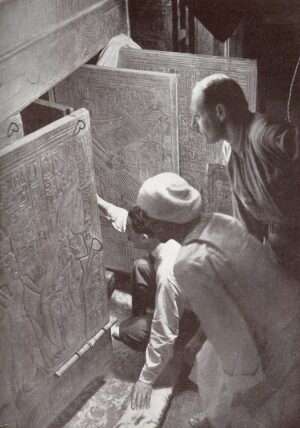
Luxor (modern day Thebes) – November 4th 2022 – 100 years after the great discovery of Tutankhamun’s tomb, many of the world’s foremost Egyptologists and other officials convened at the Sonesta St. George Hotel in Luxor, Egypt from November 4-6th to pay homage to the once-in-a-lifetime event, presenting papers of their most recent findings. The Tut centennial conference was a free event hosted by the American Research Center in Egypt (ARCE) and Egypt’s Ministry of Antiquities.
No one else in the history of mankind has been so intensely studied, poked and analyzed as King Tutankhamun. For 100 years, scores of scholars have pored over every microscopic detail left on this boy king’s mummified body and the over five thousand artifacts left in his tomb, teasing out more information about his life and unraveling remaining mysteries. As Egyptologist Marc Gabolde at the Tut Centennial conference joked, “We know less today than we did then.”
Below are highlights of the most impactful recent findings presented at the conference.
Zahi Hawass — As the Keynote speaker, Zahi Hawass kicked off the weekend conference. During his presentation, Zahi made it clear he believes he has sufficiently disproven the much talked about hypothesis of Dr. Nicolas Reeves that Nefertiti’s tomb is hidden behind the wall of murals decorating Tut’s tomb. He showed the packed room of Egyptologists photos of the two scans completed inside Tut’s tomb and GPR scans of several areas of ground surrounding it that he and his team conducted.
The discovery of Zahi’s so called, “lost golden city” on the West Bank of Luxor near the worker’s village of Deir El Medina began when he was convinced that Tut’s undiscovered funerary temple must be located somewhere in the West Bank near Malkata, Amenhotep’s royal residence and the row of mortuary temples built by other kings in an area behind Medinet Habu temple. What Dr. Hawass actually found was a small city or settlement inhabited by Egyptians that in Zahi’s words, were the ones “who made the king’s great” – the artisans.
A small portion of this settlement was originally discovered by a French expedition in 1934-5 (Robichon & Varille) but was left unexcavated. Currently, the active excavation of the site is divided into 6 districts. Two districts remain to be fully explored. The most recent discovery of a stamped clay artifact finally revealed the true name of the site – “The Dazzling Aten” believed to be founded by Amenhotep III – Tut’s grandfather, since he preferred associating his rule with the Aten. Amenhotep III was the most powerful king of the New Kingdom, even recognized by the kings of Babylon as the most powerful king in the world at the time.
Further newly discovered evidence proves the city was a center for artisans like nearby Deir el-Medina’s village of tomb builders. This settlement housed workshops that produced many fine materials for the elite. Light blue painted pottery —the fine China of the time — indicative of mid-18th dynasty to early 19th dynasty styles have been found inside many buildings. The team also discovered a pile of expensive tanned leather and remnants of a gilded sandal along with other sandal fragments. Supporting it was a leather workshop where workmen crafted sandals for royalty and possibly even King Tutankhamun. More discoveries at this “dazzling city of the Aten” have uncovered a jewelry workshop where clusters of unworked semiprecious stones were found. Other spaces reveled a linen processing room and a faience fabrication center. Many doorways in the city were hastily sealed with bricks and materials left behind, and with pots left in place, suggesting that Akhenaten quickly closed the city when he moved the capital to Tel El Amarna. Zahi believes Tut reopened the city during his reign, but excavations continue, and more evidence is needed to prove Zahi’s theory that this city was reopened by Tut after his father died to create the glorious artifacts found inside his tomb. The excavations continue.
Zahi also announced that he still believes the mummy of Nefertiti is one of the unidentified mummies titled “Younger and Elder lady from KV35”.
These latest discoveries are all highlighted in a recently released Discovery Plus documentary that covers ongoing excavations at the “Lost Golden City”.
Lord George and Lady Fiona Carnarvon presented their new book, The Earl and the Pharaoh written by Lady Fiona, the 8th Countess of Carnarvon and wife of Georgie, the 8th Earl of Carnarvon. Her book details the back story of Lord Carnarvon’s life and his life-long friendship with Howard Carter. Lord Carnarvon’s family has lived at Highclere Castle for over 1200 years (which happens to be the film setting for Downton Abbey). Lord Carnarvon was an archaeologist and avid motorist before falling ill from an auto racing accident. He was also an avid photographer and had worked on digs in Egypt as well as at an iron age fort overlooking Highclere Castle. It is on this hilltop where Lord Carnarvon’s body was finally laid to rest after his death in April of 1923.
In 1922, he and Carter pored over a map of the Valley of the Kings, searching for a potential area to excavate. Eventually, they pinpointed an area beneath the worker’s huts for the tomb of Ramses VI, which was one of the only areas yet to be explored. That later proved fruitful and was exactly where King Tutankhamun’s tomb was found after over a decade of digging in the Valley. After the discovery, Carter waited twenty-two days for Lord Carnarvon to arrive so they could open the wall leading to the antechamber together. Lord Carnarvon arrived with his daughter, Lady Evelyn Beauchamp on November 26th. He stood beside Carter as he opened the tomb and 20th century eyes peered inside for the first time in over 3200 years. Throngs of dignitaries and Egyptian officials watched on as the glorious artifacts were carefully removed one by one.
Lord Carnarvon believed the artifacts should all remain in Egypt and that Tut should remain inside his coffin. The Carnarvon family remains passionate about Egyptology to this day and there are excellent replicas of Tut’s throne, tomb, mask, sarcophagus, and others on display at Highclere Castle for guests to view. Carter and Carnarvon were beloved friends and fellow explorers.
Francisco Bosch-Puche – The Tutankhamun archive is the most important collection within the roughly 160 pieces managed by the Griffith Institute Archive at the University of Oxford. The core of the collection consists of the complete record covering the ten-year excavation of the tomb including Howard Carter’s diary. This was all donated by Carter’s niece after his death in 1939 and has since been fully digitized and made accessible online for all to research. The archive includes maps, plans, object cards, drawings, journals, diaries, notes, correspondence and the ever-important collection of photographs and glass plate negatives of Harry Burton taken at the time of Tutankhamun’s tomb discovery. A new, free exhibit hosted by the University of Oxford and the Griffith Institute attempts to tell the story from the perspective of the archaeologists and the Egyptian team of workers on the ground, bringing the archive to life. The exhibit runs until Feb 5th, 2023 at the Treasury Weston Library at the University of Oxford, U.K.
Dr. Marianne Eaton-Krauss – Presented a brief paper comparing the discovery of the tomb accounts found in Carter’s journals, diaries housed at the Griffith Institute, Oxford with supplementary information acquired from museum archives in Leipzig, Bremen and Dallas. She corrected the record, detailing errors from a slew of other researchers. At the end, she announced her retirement from public presentations, peer reviews and book reviews after a long (over 50 years) and esteemed career in Egyptology at a time when few women worked in the field.
Salima Ikram – Presented on the trials and tribulations of Tutankhamun’s mummy and what his mummified remains have gone through after over a hundred years of research. His mummy has been officially examined in the 60’s, 70’s, 2005 and 2021/2022. Tut’s skeleton had to be disarticulated in several pieces to remove all the jewelry and the golden mask. He was buried with an erect phallus, stuffed at a 90-degree angle in order for him to symbolically regenerate as Osiris in the afterlife.

Salima explains how she no longer uses the cross-arm placement of royal mummies for dating purposes as Tut’s arm position was lowered because of the heavy adornments. She showed the differing ways the boy king has been depicted over time by different reconstructions revealing cultural biases. Some present him feebler than others. Salima reinforced a new approach – that Egyptologists should be careful about inferring that he was sickly as he may not have been. It was Carter’s and Lord Carnarvon’s wish for Tutankhamun not to leave his tomb, so his body was re-articulated and placed back in his tomb where he remains today inside the Valley of the Kings. He is the only mummified king still inside his tomb.
Supporters of the sickly pharaoh theory point to the more than 130 walking sticks found in Tut’s tomb. It’s worth noting however, that ancient Egyptian officials were often depicted with walking sticks as a sign of their authority at public appearances or ceremonies. “Walking sticks do not necessarily mean infirmity.” Additionally, these walking sticks do not exhibit heavy use — they are instead only lightly worn.
She stated that his tomb was full of athletic equipment, so he was most likely an athletic young man instead of the sickly representation seen in recreations online. Cultural biases change the way we perceive these larger-than-life historical figures, and it is the job of archaeologists to steer clear of these biases and interpret the evidence that leads to the truth. Representations of Tut by different researchers around the world show how they interpret the data regarding Tut’s appearance in a variety of ways.
If Tutankhamun was, in fact, relatively healthy, it’s possible he played another role, too: that of a warrior. For evidence of this, Salima Ikram showed representations of Tut seated while drawing a bow and arrow in the same position as his father Akhenaten was presented in previous depictions at Amara. It seems he was simply following the artistic style of his predecessor.
Recent research on Tutankhamun – from new interpretations of X-rays and CT scans to studies of his footwear — are finding new evidence that Tut wasn’t as debilitated as previously believed. In a 2010 letter to the Journal of the American Medical Association, James Gamble, an orthopedic surgeon at Stanford University, stated that he did not see a clubfoot in the CT scans. Other Egyptologists such as American Bob Brier, echoes this idea after studying Burton’s original photographs before Tut’s body was removed from his sarcophagus, positing that he did not suffer from a clubfoot. Brier also notes blocks from Tut’s Mortuary temple discovered re-used in the Avenue of the Sphinxes and reconstructed by Egyptologist Ray Johnson. Ray’s drawings reveal Tut sailing back to Egypt on a boat, victoriously carrying a Syrian war captive with him. The block could represent state-sanctioned propaganda, but it is a promising clue. Another recreated scene from the blocks portrays detached hands of Syrian captives skewered on spear tips held by Tutankhamun and other Egyptian soldiers. Evidence shows Egyptians would count the removed hands of victims to count the casualties of the enemy forces after battle.
Thus, a different portrait is emerging from what is traditionally repeated in popular media, and even in scientific publications. There is a more cautious perspective among Egyptologists and an opening towards the belief that maybe he wasn’t as sickly as previously believed. Maybe he was a warrior and excelled at combat by chariot? He probably didn’t see much battle since he inherited the throne at the age of 9 but wear and tear on his 6 chariots and his leather cuirass (armor) left in the tomb does suggest “more than average use”.
Salima ended her presentation with a moment of silence to salute Carter, Carnarvon and their entire Egyptian team of workers that carefully excavated and documented Tut’s tomb from which we have so much to study today.
Dr. Ashraf Selim – Presented new CT findings on Tut’s mummy refuting or confirming details found in previous examinations of his mummy, which was about 5 foot 4 inches and likely stood at about 5 foot 6 inches. He had a slight cleft palate and an overbite found in other kings of the 18th dynasty (the Thutmoid features).
Dr. Selim detailed how the pharaoh’s legs appear to be symmetrical; with no signs of asymmetrical wear evident on the dozens of pairs of shoes and sandals buried alongside him. This finding supports the possibility he may have walked normally and did not in fact, suffer from a clubfoot.
He illustrated how the ancient Egyptians must have had a highly skilled knowledge of anatomy over 3000 years ago, because they knew the thinnest part of the skull was the nasal cavity. That is precisely the spot where priests would break through to extract the brain, later filling the cavity with natural resins. Tut’s skull shows the presence of another suboccipital route used to remove the brain and two different resins used to fill the brain cavity.
After the organs were removed, embalmers would fill the body with linen packs soaked with resin and salts (Natron). After these packs absorbed moisture within the body, they removed those packs and replaced them with fresh, dry linen packs. They were also aware of the damage microbes can cause to the body. This was evidenced through the practice of embalmers taking care to completely cover the body with resin so no organisms could enter through the pores of the skin. Two or three different embalming fluids were found to be used to mummify Tut’s body. They also found that Tut’s skull was elongated but not from binding or dolichocephaly. It was simply a genetic feature inherited from his parents.
Dr. Selim believes that, based on the evidence, Tut did not die from a hippopotamus bite but rather potentially from a malarial infection. We may never know for certain.
Sahar Saleem – Presented her findings of the first ever CT scan of ancient Egyptian mummified fetuses. There was no methodology on imaging of developing fetuses, so she invented one by studying modern aborted fetuses. Tut’s two stillborn female daughters (6 and 8 months old) were conceived with his half-sister wife – Ankhesenamun — and most likely died as a result of inbreeding. The sisters were found mummified and placed in two gilded coffinettes inside an undecorated wooden box inside Tut’s tomb. She puts to rest the “alien baby” belief, explaining that they looked ‘alien’ resulting from deterioration and poor conservation of the mummies after being placed in museum storage drawers for decades without proper atmospheric controls.
She found that Tut had oligodactyly, where his right second toe had a bone missing, making it shorter than the same toe on the other foot. Also, he had Freiberg disease (also known as Köhler disease) causing limited mobility as well as preventing circulation of blood to his foot. She favors the theory he had mild club foot and minor arthritis caused by walking on the side of his foot. She also shared details that Tut was mummified to a high standard, packing his body with fine linen packs and the most expensive of imported resins.
Sahar highlights that the mummification of Tut’s phallus in an erect position was unique to him. Other phalluses of kings were occasionally stuffed but always flaccid. Embalmers also used subcutaneous fillers in areas around the mouth to make the mummy seem more life-like. Coincidentally, these are precisely the same areas plastic surgeons use today for facelifts.
Dr. Yehia Gad presented a genotyping of some members of the Late 18th Dynasty. DNA testing on Tutankhamun’s mummy in 2010 showed that Tutankhamun’s father and mother were siblings. His father, Akhenaten, bore a son with his own sister, the so-called Younger Lady found in the tomb of Amenhotep II (KV35). Thus, the mummy of the Younger Lady would be Tutankhamun’s mother as well as sister of his father, Akhenaten. Such marriages were a royal custom which kept the pedigree pure and reduced the risk of ambitious in-laws making claims to the throne. The ancient Egyptians seemed to be unaware of the health implications for their offspring.
Resin made it very difficult to examine Tut’s DNA. Resin was coextracted with the DNA since his mummy was so heavily coated. There is no DNA currently present for Younger or Elder lady mummies as well as Thuya and Yuya. We have DNA for Akhenaten’s sister Kiya but as to the KV35 Elder lady, we do not currently know which wife she is. Perhaps she is another unknown wife?
While KV35 Younger lady has been identified as Tut’s mother, no one knows what her name is since she was found in a cache without her sarcophagus, name tags or wrappings. Whoever she is, she is a full sister of the KV55 mummy, currently believed to be that of Akhenaten.
KV21 A & B mummies have been studied and there is still debate of who their DNA belongs to. They remain unnamed as well.
Nefertiti’s mummy has still not been definitively identified among any mummies currently found.
Next generation sequencing and genomic phenotyping promise to uncover more facts. Both are new technologies where whole genome sequencing can be acquired. These unidentified mummies will assuredly be further studied. As a result of the practice of marrying within the family to consolidate power it is difficult for researchers to pinpoint DNA for these members of the 18th Dynasty. It is a contorted and tangled web to untangle for years to come.
Dr. Katja Broschat – Presented on masterfully crafted glass inlays found inside his tomb. There is some evidence of glass inlays used in the 14th century but not as expertly or refined as she found in these examples from Tut’s tomb. There are examples of sculpted glass like the serrated glass teeth found embedded into his sickle and in the vulture beak and cobra head on his famed gold death mask.
Artisans heated the glass until it was a paste and pressed into place inside the objects. They did not pour into the molds as they did not have the technology to heat glass to the degree required for liquification. Many colors of glass were utilized for Tut’s decorative jewelry and on his gilded throne but they also used clear glass and reverse painted the material to mark the pupils. This is found in representations of Cobra eyes. Black wax was also utilized. Calcite was also used as inlays for the eyes. Patterns faded over time can be teased out using UV light, color manipulation and infrared filters. A prime example of this is found in the painted bust portrait of Tut on his earrings revealed by using UV light. This is the only known example of a portrait of a king painted on a piece of jewelry.
Another example was the color manipulation revealing hidden details of feathering patterns reverse painted in glass pieces found in the tomb and Nubian captives painted into the glass inlay representing his foot cushion on his gilded throne.
After her presentation, Katja commented on the lime-green glass scarab forming the pectoral. It is made from Libyan desert silica glass and one of the rarest minerals on Earth. It is a very brittle glass found in the desert and created when a meteor impacts the sand. It is rare to find a stone of that size and to carve without shattering is a feat in itself.
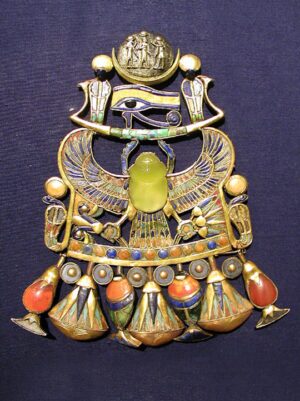
Dr. Christian Eckmann – Presented findings on over 100 gold-sheet applique’s, leather chariot harnesses and armor. Many show an international influence on their designs and Assyrian motifs. These gold-sheet and leather appliques decorated the horse trappings and chariots and have never been restored nor scientifically examined since placed in a storage magazine at the Egyptian Museum, Cairo in 1922. Drawing from Carter’s original sketches of the horse harness from 1922, Eckmann was able to unravel and make some sense of the mass of degraded material. Susceptible to changes in humidity, most of the leather harnesses for the horses were badly degraded into a viscous, glutinous mass (goo). Equally, extreme dryness can cause the leather to become brittle and eventually turn to dust. Bow cases were found to be made of leather, gesso, textile and gold. Organic binders were used to glue the layers of materials together. There was evidence that threading of the leather trim was utilized.
Tut’s leather cuirass armor was made of 6 layers of linen and rawhide scales to provide comfort as well as flexibility.
Chariots were introduced by the Hyksos and the Egyptians developed the technology further. They were part of parades, military processions, hunting and transportation for the elites. Hunting chariots were of a different design than those used for battle. Chariots were found to have tires to protect the wooden wheels and made from three different types of wood – light, hard and flexible. The chariot floors were made of leather covered with fabric or leopard and lion skins.
Shoes were found to be made of goat leather and they used bark to pad the soles for comfort and flexibility. Flexible straps were made from goat skin.
They knew of the fragility of animal skin, so they coated wooden bows with bark to make them water resistant. Arrows were also found coated with animal guts. Wooden war shields were found to have been covered with antelope and cheetah skins possibly of Nubian origin.
Some gold sheets display evidence of serial production using molds. Overall, these objects display an expertise showing knowledge of different materials and animal skins (and different parts of skins) to achieve durability. These leather objects also display knowledge of technological details such as stitching and seams.
Meteoric Iron inside Tut’s tomb – In their latest book, Iron from Tutankhamun’s Tomb, recently published in 2022, Broschat and Eckmann found a total of 19 objects crafted from meteoric iron. This is unique as there is no evidence for iron extraction from ore in Egypt at the time (page 4). Other prior examples of meteoric iron have been found in Central Anatolia, modern day Turkey. Also, inside a predynastic Naqada tomb, small meteoric iron beads were found in al-Gerzeh. Lastly, a small, iron amulet in the form of a fishtail knife (pesesh-kef) was found in the tomb of Queen Ashait, a secondary wife of Mentuhotep II of the 11th Dynasty at Deir al-Bahari (page 23).
A wooden chest inside Tut’s tomb yielded 16 small chisels set into pristine coniferous wood handles. The handles were found to have no traces of abrasion or staining on them inferring a symbolic purpose perhaps for the Opening of the Mouth ritual. The tips show corrosion not found on any of the other meteoric iron objects that is believed to have resulted from coming into contact with corrosive liquids, perhaps resins. There is insufficient evidence to come to any conclusions on these objects at this time.
Another item is a small iron amulet eye of Horus (wedjat) attached to a gold bangle bracelet. A small amulet in the form of a very small headrest was placed underneath Tut’s neck to aid him to resurrect and as protection from losing his head both physically and in the afterlife. (page 11). There is some evidence that the wedjat amulet and the headrest may have been crafted from the same meteorite. (page 31).
Finally, the most famous item of meteoric iron – the king’s dagger lavishly adorned with gold and inlays of stone and glass tipped with a jackal head of Anubis at its tip. It is believed that this was originally one of many daggers and other iron objects given to Tut’s grandfather – Amenhotep III as wedding gifts by a Mittani ruler named Tushratta, which was documented in the Amarna letters (page 24). Researchers also found evidence that the dagger’s hilt cover or handle was not the original for the blade as its outer gold filigree at its base was distorted and compressed (page 21).
How did they work these 19 objects of meteoric iron? There is no archaeological evidence for such high-temperature technology by the Egyptians at this time to support how the dagger or other objects were forged. The authors conclude that it is possible the objects were warm or cold worked and polished afterward. (page 25).
Conclusions on how the iron was worked cannot be made at this time as more comparative analyses needs to be completed. Additionally, since the New Kingdom was interconnected through networks of trade far beyond Egypt’s borders, it is difficult to find the source of the meteoric iron. Researchers did conclude that the Kamil meteorite found in southwest Egypt is a highly unlikely source for Tutankhamun’s iron objects as it is an ataxite meteor with unique compositions of nickel, cobalt and chromium.
Dr. Hourig Sourouzian – Presented on Tutankhamun and the Jackal. Representations of the Jackal or Anubis are found on the corners of the gilded skirt on both life-sized guardians (Ka statues), the tip of Tutankhamun’s golden sheath encasing his meteoric iron dagger and the large Jackal shrine found inside Tutankhamun’s tomb. The Anubis shrine was left situated directly in front of his large canopic shrine at the entrance of the treasury, guarding his organs for eternity. Sourouzian traced the representations of the Jackal in the monumental statuary of Tut’s grandfather – Amenhotep III. She showed details of the famous shrine inside Tut’s tomb which was of a recumbent Jackal representing Anubis, mounted on a pedestal. The Jackal was attached to a lid that slid open to the rear and revealed compartments that contained various ritual objects. Ritual clothing, amulets and four magnificent, bejeweled pectorals were found inside the shrine.
Carter found the Jackal figure wearing a ceremonial linen scarf wrapped around its neck under a linen shroud. Its eyes were crafted with black obsidian pupils within calcite. There were golden inlaid eyebrows and claws made of silver, blackened by time.
Niches inside the tomb walls held magical terracotta figures of recumbent jackals wrapped in linen to vanquish the dark and repel the enemy of Osiris (the deceased) and the dark powers of the Netherworld. They were placed in recesses in the walls, facing North, South, East and West.
The clay stamp sealing the tomb entrance that Carter found also bears the same jackal\Anubis image.
An interesting finding noted by Sourouzian related to two Sphinx statues placed facing each other at Karnak temple. The sphinxes bore the heads of Tut and Nefertiti. Many researchers believe Nefertiti ruled for a short period just before Tut under another name. The placement of these statues may seem to support this.
Dr. Andre Veldmeijer – Presented findings from an intricate, custom-made leather cuirass (armored vest) made from hundreds of finely cut, leather scales. It was found in a jumbled, deteriorated mass. No researcher wanted to tackle its restoration since it was in such a fragile state. Now, it has finally been carefully studied, using new archaeometrical research methods. The cuirass displayed use of complex, flexible joints on the sides to allow for movement and protection during battle. This led experts to conclude that not only was the cuirass functional, but also showed abrasion on its edges and had probably seen battle.
Dr. Veldemeijer’s conclusion is that this cuirass was not a ceremonial garment and that the ancient Egyptians had a high level of knowledge regarding armor. This further supports the new belief that Tutankhamun may have been a skilled warrior king.
Dr. W. Raymond Johnson – Presented a paper based on research of newly identified Amarna Talatat reliefs depicting a young Tut and Kiya. Dr. Johnson suggests that Akhenaten’s other wife named Kiya “Greatly Beloved Wife” may actually be Tutankhamun’s mother based on reliefs found on Talatats originally from Amarna. The positions of Kiya beside Akhenaten with her daughter and Tutankhamun combined with the absence of representation of Nefertiti suggest she may actually be his mother.
Dr. Nozomu Kawai – Was Tut a political puppet leader or figurehead like King Charles of England with the top leaders in his court making all the important decisions? Dr. Kawai attempted to find the answer in his research of depictions in stone around ancient Thebes. During Tut’s reign, court officials had a degree of prestige that was unusual for officials, at a time when the king was the conceptual center of the ancient Egyptian Universe. Was this a direct result of Tut’s very young age when he rose to the throne?
Grand Vizier Ay, the closest courtier to Tut, was shown also participating in royal cultic rituals. Horemheb is shown depicting himself as a victorious military leader and legislator. Both are traditionally roles of the king. Maya, overseer of the Treasury during Tut’s reign, was shown to be responsible for the temple restoration project throughout Egypt. He also adopted epithets solely reserved for royalty, not court officials. Kawai also posited Tut may have been manipulated by the priests, who wanted their jobs and positions of high power back along with their booming business of temple donations consistently streaming in.
Dr. Nicholas Reeves–As Nicholas Reeves began presenting his latest paper, the room fell intensely silent, occasionally interrupted by murmurs and gasps. His theory follows a thread started by Howard Carter who believed there was another hidden chamber inside Tut’s tomb, evidenced inside other tombs of the early 18th dynasty. Reeves’ paper details new supporting evidence of re-use inside Tut’s tomb.
To read more on Reeves’ sensational new findings, see the article, Tutankhamun, Nefertiti, and the Lost Tomb in this issue.
Dr. Marc Gabolde – Presented his findings from over ten years researching some missing jewelry pieces from Tut’s tomb that have been recently located. Gabolde pored through old photos, comparing Harry Burton’s original photos at the time of their discovery in 1922 with recent auction photos and other museum collections in his quest for Tut’s missing jewelry.
One major finding by Gabolde was of a double headed falcon necklace made of solid gold and strung with multicolored glass and stone beads. The necklace was extracted from Tut’s mummy in pieces soon after discovery due to being covered in the resinous goo poured over the entire mummy and interior of his sarcophagus. (According to Carter, it was estimated to be two whole buckets full of resin). The necklace is today housed at the Nelson-Atkins Museum of Art in Kansas City and they are currently considering returning it to Egypt. The museum reports that Howard Carter gifted the necklace to his surgeon (who was an amateur Egyptologist) after he performed a procedure on Carter. After the surgeon’s death, the museum purchased the necklace at auction.
Necklaces have turned up in auctions around the world and are currently held in museums such as the Royal Museum of Fine Arts of Belgium, The Metropolitan Museum of New York, the Brooklyn Museum and the St. Louis Art Museum.
A missing beaded skullcap with a double rearing cobra design made of colored beads, semi-precious stones and faience was stolen after it was left inside his sarcophagus in the Valley of the Kings after Carter finished cataloguing all the artifacts. It was likely disassembled to remove from the skull and has yet to be located.
American Egyptologist Bob Brier’s new book posits that there are other items that were potentially stolen by Carter popping up around the globe. In 2010, the Metropolitan Museum of New York announced they would return to Egypt 19 objects acquired from the 1920’s to the 1940’s that were definitively from the tomb of Tutankhamun.
Another accusation that Carter handled artifacts stolen from the tomb has emerged from a previously unpublished letter sent to Sir Alan Gardiner in 1934 by Carter. He was a leading philologist that worked with Carter on the excavation team in Tut’s tomb and was a trusted colleague. Carter asked Gardiner to translate hieroglyphs from the tomb and later gave him an amulet. Gardiner showed the amulet to a colleague who was then the British director of the Egyptian Museum in Cairo and immediately identified it, saying that it was made from the same mould as other examples found inside Tut’s tomb. Gardiner fired off an angry letter in response and the two never spoke again.
Carter may have intended to repair or study some of the jewelry but died before he could complete his analysis. Regardless of motive, Carter’s actions were “illegal”. Gabolde explained that Egypt passed laws prohibiting export of artifacts from any royal tomb found intact. The laws also stated that the artifacts belonged to Egypt, meaning that Carter could not have possibly passed them to anyone legally.
Minister of Tourism for Archaeological Affairs at the Grand Egyptian Museum – Dr. Al-Tayyeb Abbas – Explained the difficulties in restoring and placing the items inside the monumental post-modern billion-dollar museum that has taken over 20 years to complete. It took two years just to restore the four gilded and nested shrines enclosing Tutankhamun’s four nested sarcophagi and place them inside their final resting place. It was an arduous process that required opening the roof of the museum and gently lowering the shrines into the gallery using helicopters. At long last, they are safely stored inside their temperature controlled, glass enclosures.
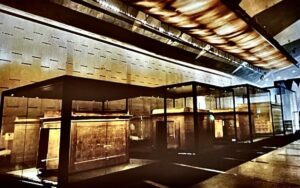
He described the outline of the two halls in the new gallery, which will display the complete collection of King Tutankhamun’s tomb contents, about 6,000 artifacts in all, for the first time ever in one gallery at the GEM. The suggested path outlining the family, life and rebirth of the boy king has two tracks. One that can be completed in 20 minutes and another in 2 hours.
The only question asked by the audience was “When will the GEM open?” The room erupted with enthusiastic cheers.
Dr. Al-Tayyeb responded, smiling, “We are also very excited for this wonderful, world-class museum to open but unfortunately, cannot give a definite date at this time. Hopefully some time in 2023.”
Tutankhamun’s Legacy
King Tutankhamun’s splendid artifacts are a time capsule and testament to the superior skill of ancient Egyptian craftsmen. They represent the life and times of Tut as well as his dream to resurrect into the afterlife.
Objects were placed specific to an activity they loved in life, so they could enjoy that activity in the afterlife. We can theorize he was an athletic young man that liked sports because there were 6 chariots and many bows, boomerangs, daggers and fighting clubs left in his tomb. He most likely enjoyed games as there were six Senet games deposited in his tomb for him to play throughout eternity. We can believe he liked to write as there were 14 writing palettes placed inside. Although, Salima Ikram explains that as of today, no writings have been found by him anywhere. We know he liked wine over beer as there were only wine jars deposited for him inside his tomb. There was a lock of his grandmother’s hair and tiny coffinettes of two, mummified stillborn fetuses of Tut’s daughters placed in the tomb to reunite with him in the afterlife.
Why does Tut resonate for people across every continent on Earth, still today, after over 100 years?
Not only is his tomb undeniably among the greatest archaeological discoveries of all time, but there is something about his stunning golden mask, one of the most valuable manmade art objects on the planet, with its blissful, Buddha-gaze that hypnotizes the viewer like a Bronze age Mona Lisa, that has become engrained in our collective psyche.
___________________________________

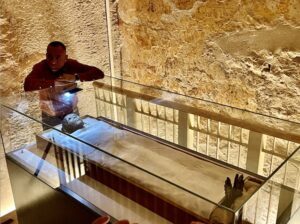
___________________________________
One is compelled to silence when standing close to Tut’s mummy. Gazing at his dormant face, his body covered by linen, feet exposed inside his oxygen-free glass sarcophagus, it feels almost like being in the presence of a god, though his ancient body is fragile and clearly human. Peering closer, you realize he was mortal like any other human. You recall the same feeling you had at a funeral, looking at a deceased family member in their open coffin. You try to imagine how his life was. What were his thoughts, his desires?
In the case of Tutankhamun, his mummified body helps one imagine his life over 3,300 years ago. His was a life marked by deep sadness. It was a tragic and very human story. In many ways, he was a hero and a victim — a victim of the royal practice of intermarrying within the family line, causing him to suffer from physical ailments, and a victim of being born into a heretic family where his father foisted monotheism onto his polytheistic country for the first time in the history of humanity. Tut was then forced to grow up very quickly and rule the most powerful empire on Earth at a prepubescent nine years of age, when most children were content to spend their days laughing and playing. He also suffered a devastating loss, failing to provide a male heir for his father. His two daughters died from severe deformations as a result of inbreeding, effectively ending his family’s 18th dynasty. Additionally, he lost his father at a very young age and soon after, suffered the loss of his mother/stepmother (still debated) Nefertiti.
He was also a hero. Whether a puppet leader or not, he agreed to make Egypt great again. He moved the capital back to Thebes, reopened the temples and returned the traditional pantheon of gods to the people of Egypt, restoring Amun’s prominence. He also rebuilt stelae, shrines, and buildings at Karnak. He added works to Luxor temple and started restoration of temples throughout Egypt that were previously pillaged by his father. He also erected many statues and sphinxes in his likeness at Luxor temple and Karnak.
But we should think about these historical figures within a human context and not as idealized heroes or celebrities. In the end, Tutankhamun was just a boy that became king first, then a man dying at a very young age of about 18.
Even though he has been stripped of all his objects, he might be content knowing we still say his name thousands of years later. In this sense, the ancient priests were successful in controlling his fate, ensuring his immortality inside their king’s sacred resurrection machine.
‘May your spirit live, may you spend millions of years, you who love Thebes, sitting with your face to the north wind, your eyes beholding happiness.’
(Magical spell engraved on Tut’s alabaster wishing cup and on Howard Carter’s gravestone at Putney Vale cemetery in London)
In the end, King Tutankhamun’s story is more than just a boy king that restored the Egyptian empire. He is a reflection of our own mortality. His story is still incomplete and undoubtedly will continue to be studied for another 100 years.
In the words of Zahi Hawass, “He is everyone’s ancestor – everyone’s son.”
*estimate
References:
- The Countess of Carnarvon, Dec 6, 2022 – The Earl and the Pharaoh
- Griffith Institute –Complete Diary of Howard Carterdetailing discovery of King Tutankhamun, day by day.
- Griffith Institute at Oxford exhibit until Feb 5, 2023 –Tutankhamun excavation archives
- Marianne Eaton-Krauss, Dec 17, 2015 – The Unknown Tutankhamun
- Katja Broschat, Florian Strobele, Christian Koeberl, Christian Eckmann & Eid Mertah, June 2022 – Iron from Tutankhamun’s Tomb
- Bob Brier, October 27, 2022 – Tutankhamun and the Tomb that Changed the World
- Curtis Ryan Woodside, Nov 25, 2022 – Documentary The Daughters of Tutankhamun
- Visit the Tutankhamun: Excavating the Archive exhibit at the Treasury, Western Library at Oxford until Feb 5, 2023
- Virtual Tour of Tut’s tomb – For the first time in history you can experience a free Virtual Reality tour of the tomb of the world’s most famous King from the comfort of your home.

